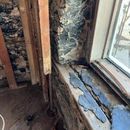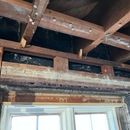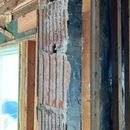Advice for insulating a 100+ year old Fieldstone and Stucco Home (Border of Zone 4/5)
We are in the process of restoring a home originally built in the late 1800’s and updated in the 1920’s after a fire. The plumbing and HVAC were failing, and the electrical was a challenge, so we had to take it down to the studs. The base of the home is ~30 inch thick fieldstone held together with I’m guessing cement on the ground floor (front exposure has basement/garage with back side built into a rock 10 feet high) and first floor (~18-24 in thick) fully exposed. It transitions to filled terra cotta blocks covered with stucco for the 2nd floor (~12 in thick). The stone and stucco were covered on the inside with a black material that appears to have been some sort of water/vapor barrier coated on? There were virtually no signs of water penetration, moisture damage, mold or rot. The floor joists go directly into the stone and there are some steel beams as well.
The interior was inch thick plaster on metal lath. Between the stone/stucco and the plaster was a 2-3 inch airgap created by the wood studs. Most of the studs were not against the stone. There was no insulation in any of the walls and limited insulation in the attic floor. Heating and cooling were expensive, but surprisingly not as much as I would have thought given virtually no R-value of the walls. I’m attaching a couple of pictures to help describe.
The challenge: we are getting different opinions about the right way to insulate the interior walls (exterior is not an option given the beautiful stone and stucco exterior). I have read the GBA forums extensively and it seems like the preferred approach has evolved, but I’m not sure which direction to go. The options seem to be: 1. Closed cell insulation directly on the interior stone/cement/blocks, keeping the studs off the stone at least an inch to help avoid thermal bridging (although one sub suggested open cell to let it breathe). 2. Create some sort of air gap next to the stone using a dimple material or other, then start the insulation (closed cell or open?) 3. Rockwool or other breathable insulation that won’t absorb moisture in the cavity without an air gap. Maybe there are other options.
We lived in the house for several years and in general it did not appear to have any meaningful air or water penetration: quiet as a mouse with big storms. We are replacing the roof and will fully enclose and insulate the attic. We are planning on installing a ground sourced heat pump system for HVAC. Happy to provide any additional information and would love to get the advice and/or hear the debate from the amazing experts on this forum. Thank you.
GBA Detail Library
A collection of one thousand construction details organized by climate and house part













Replies
Folks much smarter than us have done a lot of work on this topic. You can read about it here:
https://www.buildingscience.com/documents/digests/bsd-114-interior-insulation-retrofits-of-load-bearing-masonry-walls-in-cold-climates
https://www.buildingscience.com/documents/bareports/ba-1105-internal-insulation-masonry-walls-final-measure-guideline/view
If you search the site, they have more details dealing with masonry.
Since it doesn't sound like you have major water ingress issues, the closed cell spray foam is the simplest. Dimple matt won't do anything and might actually make things worse, so I would not bother with it.
I'm not 100% sure about open cell. Open cell is considered air permeable up to 5" or so you need a thicker walls for it to work. I think the 2" or so of ccSPF followed by batts is your lowest cost option that doesn't take up too much space.
Thanks Akos. I read these reports today: very helpful. It seems like they lean towards closed cell if only 3 inches of space but ok for open cell if 5+” to allow for some internal stone wall drying? It wasn’t perfectly clear on that. But it certainly seemed conclusive to NOT do any air barrier or dimple mat as you said. Has anything changed with insulating foam since the article came out in 2011? Their reference to a medium cell middle ground that had some interior drying but kept the R-value seemed interesting. I’ll have ~3-4” to insulate with and then add that to the stone wall R value makes it tight.
You don't want the stone walls drying to the interior. You want to keep that moisture out of your house. The old-timers knew that, which is why they coated those walls with tar.
Are you willing to lose a little bit of interior space? I think your best bet is to make the interior walls thicker, 2-3 inches is really marginal when it comes to insulation.
It sounds like you have good air sealing. Generally the way you want to build an exterior wall is to have the warm side have a vapor barrier, have the cold side dry to the exterior, so that any humidity that gets into the wall gets driven out by the vapor drive of the temperature difference. But it sounds like your walls are vapor tight to the exterior. This is called a "wrong side vapor barrier," it requires some special steps. First, the wall has to be vapor open to the interior so that when it's hotter outside than inside the wall can dry to the interior. Second, you need to have a layer of air-tight, impermeable insulation against the cold side, so that any moist air that gets into the wall never comes into contact with anything cold enough to cause condensation. This layer could be spray foam, or it could be a layer of continuous foam board if you're willing to take up the studs. I wouldn't recommend fitting foam between the studs, it won't be air-tight enough. If you want additional insulation you can use batts or blow-in inboard of the foam.
Thanks DC. Not sure about the wrong side vapor barrier concept. There is nothing on the outside besides stone, grout and stucco so I don’t think that would be the case unless you are saying the tar/black stuff on the inside of the stone walls would do that? Either way, it sounds like you are also suggesting foam insulation directly on the inside walls with no gap. Do you have a view on open cell vs. closed cell or something inbetween? We will have ~3-4 in for insulation.
Yes, the tar is the vapor barrier. It's on the wrong side of the insulation.
I forget the exact number, but open cell has to be pretty thick to form an effective air barrier. Closed cell is an air barrier at just about any thickness.
We are headed to framing and based upon the building science articles and some additional conversations, thought I would share our plan for any final thoughts/advice.
We are planning on framing the interior walls with 2x4” fir studs set 1” off the stone (so 5’ deep total). Will use at least 3” of closed cell insulation applied directly to the stone masonry. Given the closed cell low vapor, air and water permeability we are not planning on applying any additional tar or other barrier to the inside of the stone. Interior walls finished with drywall and paint.
We are planning on leaving the existing embedded floor joists in the stone and insulating around them to try to avoid any air from inside penetrating into those cavities that used to be uninsulated. In a couple of areas where new floor joists are required, we plan on attaching an LVL directly to the stone masonry then having new TJIs from that. The LVL would be encased in closed cell as well to try to avoid any bridging and condensation.
Never thought doing the renovation would be this technical. Thanks for any final thoughts or advice.
Are you planning on applying a sealer to the exterior? I would; you don't want the stone or mortar to become saturated, freeze and spall. Otherwise I think your plan is good. I avoid foam when possible but this is a case where nothing else would work as well. Keeping the foam relatively thin minimizes up-front carbon emissions and means there will still be some heat energy to push moisture through your wall to the exterior, which is a good thing.
We were not planning on applying a sealer to the exterior as we had not noted any significant water penetration/leakage on the walls to date (albeit per original post the above grade were behind plaster). Exterior walls are fieldstone on lower half and stucco on upper half. Was also not planning on applying/reapplying the interior sealer/tar/other that was originally there as it seems like the closed cell insulation serves that purpose? Is that right?
Was hoping to get some advice on specific insulation types./brands. Per above we are planning on using closed cell insulation applied directly to the interior stone walls through the house as well as around all LVLs and steel beam embedded into or mounted against the stone. Any recommendations on specific types/brands of closed-cell insulation that would be best for this situation? Thanks.